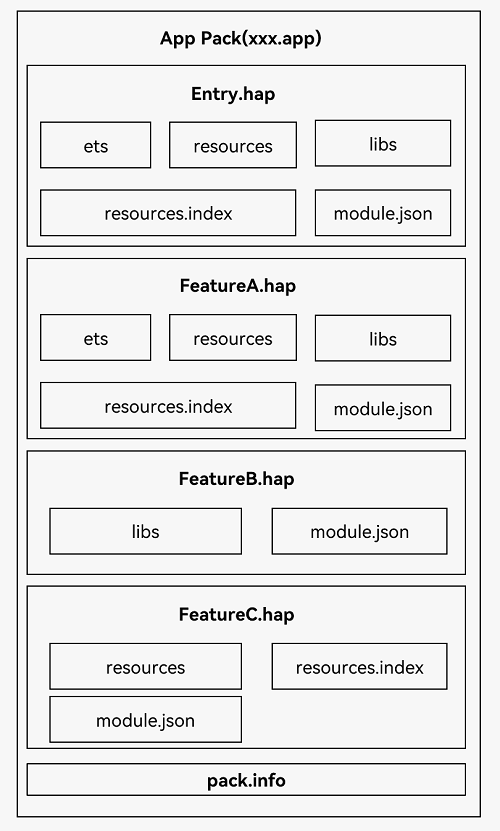Application Package Structure in Stage Model
To develop an application based on the stage model, it will be helpful if you have a basic understanding of the structure of the application package created after the application is built and packaged, as well as the related basic concepts.
-
In development, an application contains one or more modules. You can create modules in the application project in DevEco Studio. As a basic functional unit of an OpenHarmony application/service, a module contains source code, resource files, third-party libraries, and application/service configuration files, and can be built and run independently. Modules can be classified as Ability or Library. A module of the Ability type is built into a Harmony Ability Package (HAP) file, and a module of the Library type is built into a Harmony Archive (HAR) file or a Harmony Shared Package (HSP). A module can contain one or more UIAbility components, as shown in the figure below.
Figure 1 Relationship between modules and UIAbility components

Unless otherwise specified, the modules described in this document refer to the modules of the Ability type.
-
As aforementioned, you can build an application into one or more HAP files. The HAP file is the basic unit for installing an application. It provides code, resources, third-party libraries, and a configuration file. HAP files can be classified as Entry or Feature.
- HAP of the entry type: main module of the application, whose type field is set to "entry" in the module.json5 file. In an application, each type of device supports only one HAP of the entry type, which is typically used to implement the application's entry screen, entry icon, or headline feature.
- HAP of the feature type: dynamic feature module of the application, whose type field is set to "feature" in the module.json5 file. Each application can contain zero, one, or more HAP files of the feature type, which are used to implement the application features. You can configure this type of HAP file to be downloaded and installed independently as required or to be downloaded and installed together with the HAP file of the entry type. For details, see deliveryWithInstall in module.json5 Configuration File.
-
All the HAP files in an application are integrated into a bundle, and the bundle name is the unique identifier of the application. For details, see bundleName tag in app.json5 Configuration File. Note that to release an application to the application market, all HAP files (that is, the bundle) contained in the application must be packed into an Application Package (App Pack) in .app format, which also contains the pack.info file that describes the attributes of the App Pack. The App Pack is distributed and installed on the cloud and on the device on a HAP-by-HAP basis.
-
The HAP file includes folders such as ets, libs, and resources and files such as resources.index, module.json, and pack.info.
- The ets folder stores bytecode files generated after application code build.
- The libs folder stores library files, which are .so binary files that contain third-party code on which the OpenHarmony application depends.
- The resources folder stores resource files (such as strings and images) of the application. For details, see Resource Categories and Access.
- The resources.index file provides a resource index table, which is generated when the application project is built in DevEco Studio.
- The module.json file is the configuration file indispensable in a HAP file. It consists of module.json5 and app.json5 in the project configuration. While DevEco Studio provides default configuration, you must modify the configuration as needed. For details about the configuration fields, see Application Configuration Files in Stage Model.
- The pack.info file describes the HAP attributes in the bundle, for example, bundleName and versionCode in app and name, type, and abilities in module. The file is automatically generated when DevEco Studio generates the bundle.
Figure 2 Application package structure in stage model
